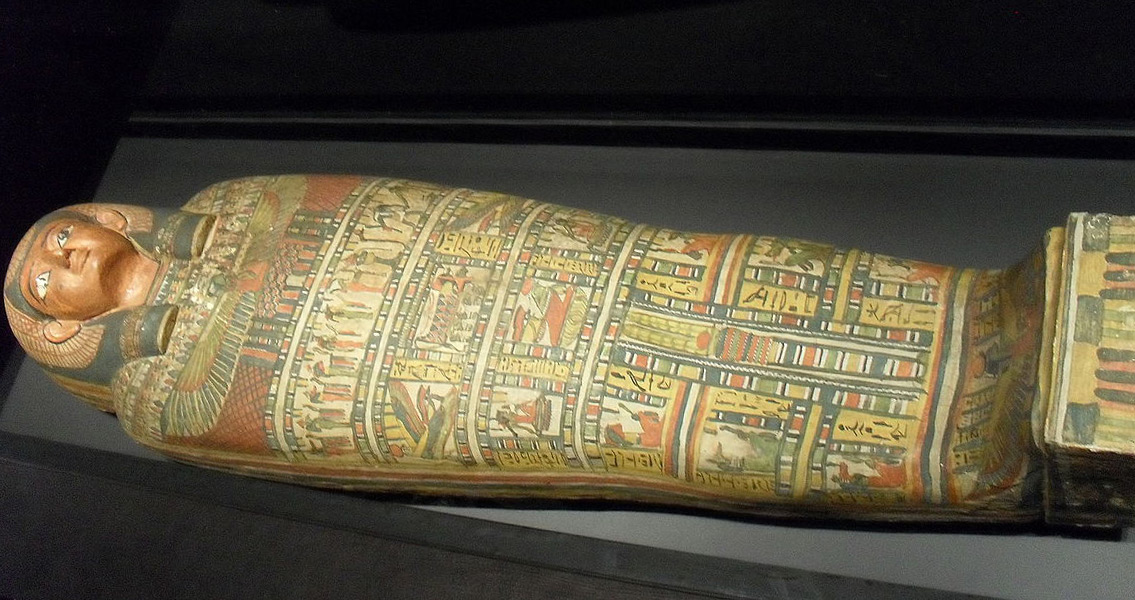<![CDATA[An ancient Egyptian coffin decorated with crude, amateurish drawings has been revealed. The coffin holds important clues about a tumultuous period in Egyptian history. Analysis of the coffin's drawings was recently presented at the Society for the Study of Egyptian Antiquities Scholars' Colloquium by Gayle Gibson, Egyptologist at Toronto's Royal Ontario Museum. There are numerous odd features in the coffin's decoration which, Gibson thinks, reflect a lack of knowledge on the part of the artist. In one picture, the deceased individual is depicted lying on their death bed. The bed, interestingly, has a human-headed bird called a Ba. Above the deceased is a winged snake wearing a crown, possibly a depiction of the goddess Hathor. Below them are four jars depicting the four Sons of Horus, although Gibson told Live Science these jars have a "goofy" appearance. "This is the only funerary bed I know of with a Ba's head," she told the Toronto audience, also noting that "we have a winged snake with Hathor's crown very odd." A Mehen snake, a deity which coils itself around vulnerable individuals to protect them, is very poorly drawn; it stops at one point and starts at another. Gibson sees this mistake as an indication that "the artist doesn't really understand the purpose of the Mehen snake." Despite there being no mummy in the coffin, inscriptions say that it belonged to someone named Denit-ast, or Dent-ast, most probably a woman. Radio-carbon dating of the coffin's wood has revealed it to be around 2,400 years old. The coffin, therefore, comes from a turbulent period in Egyptian history. In 525 BCE, the Persian King Cambyses captured the Egyptian capital of Memphis, instating a period of Persian rule which would last more than a century. A later written account by Diodorus Siculus, who died around 30 BCE, claims that Cambyses sent precious materials and skilled artisans from Egypt to Persia. "Many of the best artists in Egypt were taken by the Persians back to Persepolis and Susa as POWs and war booty you can see their work in those places. There seems to have been a dearth of masters [in Egypt] for some time, so that fewer and fewer artists got proper training," Gibson explained. There has been some debate as to whether the coffin is a fake, as such crude drawings are rarely seen on ancient Egyptian coffins. Analysis of the wood has revealed the coffin to be made of sycamore, a material commonly used in ancient Egypt, while the blue pigments in some of the coffin's artwork are Egyptian blue, further indicating it is indeed from ancient Egypt. Despite its crude and strange decorations, Gibson is confident the coffin is authentic. "I think there is really no doubt that this one is genuine," she said. There is strong evidence that the coffin is a genuine ancient Egyptian artefact. It is very rare for any coffin to have survived 2,400 years, and most of those that have tend to be lavishly adorned with beautifully-crafted artwork. The crudeness of this particular coffin provides important evidence of a 'brain drain' in Egypt, following the Persian conquest. This amateurish coffin allows us to glimpse the effects of the Persian Empire's policies in physical terms.]]>
Crude Coffin Artwork Contains Clues to Persian Conquest
